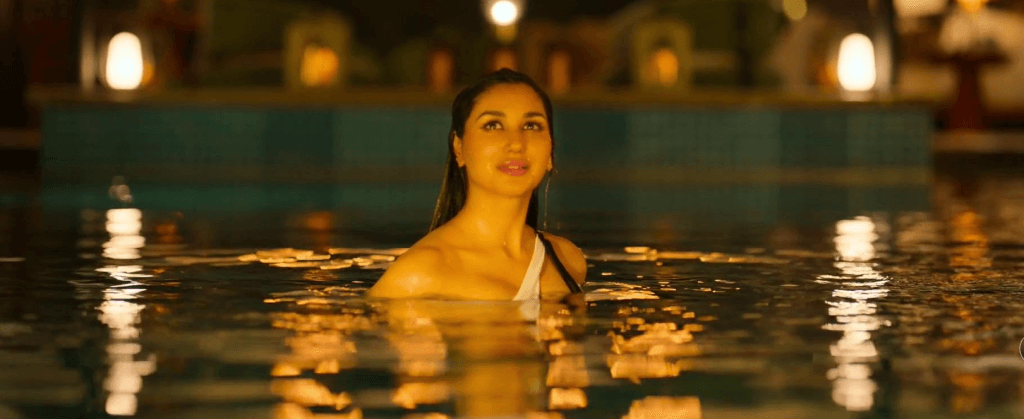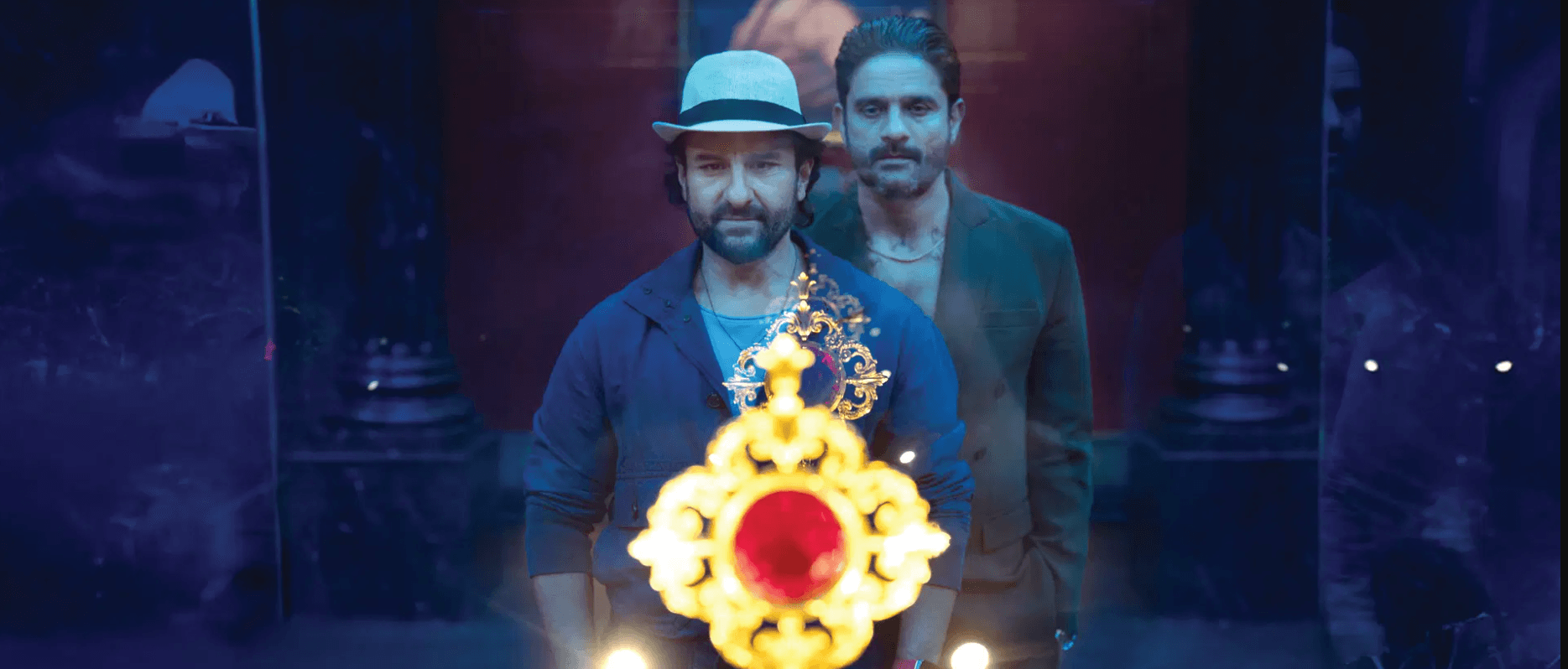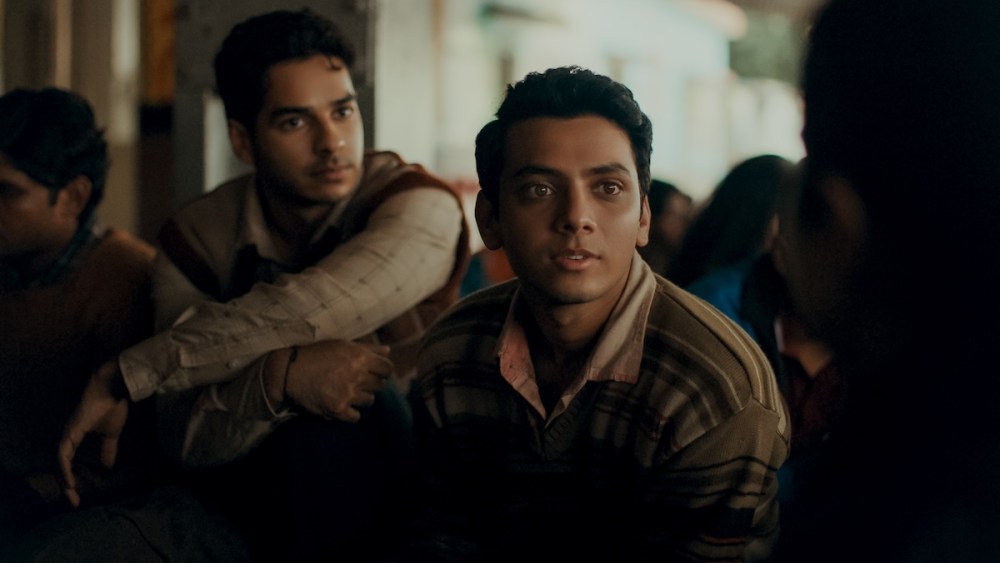Jewel Thief: The Heist Begins (2025) is an action-packed heist thriller directed by Robbie Grewal and Kookie Gulati, marketed as a spiritual sequel to the 1967 classic Jewel Thief directed by Vijay Anand. The film stars Saif Ali Khan as Rehan Roy, Jaideep Ahlawat as the criminal mastermind Rajan Aulakh and Nikita Dutta in the role of Farah, Rajan’s partner.
The film blends nostalgia with modern cinematic techniques but falls short in portraying female characters. For instance, Farah, the only notable female presence on screen, had the potential to be so much more–a player central to the heist, a strategist, a wildcard. Instead, she is reduced to a familiar trope: the damsel in distress. This choice diminishes Farah’s character and highlights a broader issue: despite decades of progress, the film continues to follow a male-centric plot.
Jewel Thief: The Heist Begins doesn’t fall short on style or suspense—it has plenty of both, but it misses an opportunity to evolve. With the talent and resources to create nuanced female characters, it chose a familiar path instead. With the promise of delivering something fresh, it settles into something familiar.
Male-centric narrative and the marginalisation of female characters
The plot of Jewel Thief feels profoundly male-centric at its core. Saif Ali Khan’s Rehan Roy is shown as the clever mastermind, while Jaideep Ahlawat’s Rajan Aulakh plays his strong rival. Their back and forth takes over the whole film and leaves hardly any space for the female characters to actually grow.

Meanwhile, Nikita Dutta’s Farah, who is supposed to be the main female lead, gets pushed off to the sidelines. Her character doesn’t seem to have much depth or agency, and there isn’t a proper arc for her either. Through the film, she ends up being more of a prop, just to help move the male storyline ahead. This marginalisation reflects broader issues across cinema where women in films exist only to support the male-driven story, not being given the chance to be their fully realised individuals with their own personality, nuances and complexities.
Jewel Thief and the reinforcement of gender stereotypes
Farah’s character in the film falls into the old and outdated damsel-in-distress stereotype. She is depicted as a victim, with her pain and suffering used as a catalyst for Rahan’s actions. This not only strips her of her own agency but also portrays women’s experiences as only mattering as long as they influence a man’s storyline.
The film had a real opportunity of giving Farah a storyline of her own while highlighting her strength, intellect and personality without taking away from the overall plot of the story. Instead, her character was reduced to being a mere passive presence on the screen. This further reinforced conventional gender roles that have long been critiqued in feminist discourse.
Lack of female agency in the heist narrative
Heist films traditionally offer a stage to highlight strategy and teamwork across a range of characters. And yet again Jewel Thief gives all that credit just to the male leads. The whole heist is planned by men while the women barely show up in any of the main action. This keeps pushing the idea that leadership and smart thinking are just male traits and also misses out on a chance to build a story that’s more inclusive and lets women have important roles too.

In contrast, films like Oceans 8 and Windows have shown us that women can lead heists with skill, intelligence and emotional depth. Both these films show that strategic brilliance is not gender bound at all. This is something Jewel Thief falls to do while sticking to a narrative that sidelines female agency.
What feminist storytelling could have looked like in Jewel Thief
Jewel Thief had real potential to redefine the genre of heists with the incorporation of strong and complex female characters in the narrative. For instance, Farah could have been shown as a central part of the heist which highlighted her personality and intellect.
Another strong option could have been to add a female villain or even a rival mastermind—something that would bring more tension to the plot and genuinely make it feel more believable. Stuff like that could’ve pushed the story beyond the usual clichés. These kinds of creative choices not only would have added layers to the narrative but also challenged traditional gender roles, leading to a film that felt more fresh and forward-looking and just more gripping overall.
A regressive remake: Comparative analysis with the 1967 original
The 1967 Jewel Thief’s prominent female characters, who were although still shaped by the gender expectations of their time, still managed to contribute to the story’s plot and intrigue. While the female lead did revolve around a male lead who had a noticeable presence and narrative weight. On the contrary, the 2025 remake completely sidelined its female character with no agency and very limited screen presence. Instead of adapting with time and portraying a contemporary and feminist perspective, the remake retreats even more into a reductive portrayal.

Nearly six decades later, we are met with the same stale and outdated gender roles casting women as “romantic interests or ornamental figures” rather than their person. This is not only a missed opportunity but also a reflection of a deeper reluctance within mainstream Bollywood cinema to rethink genre narratives in a way that places their female characters at the centre. The film had real potential in how women can be presented in cinema but instead it falls back on worn-out tropes.
Beyond representation, toward imagination
Jewel Thief: The Heist Begins (2025) serves as a reminder of ongoing gender balance in mainstream Bollywood cinema. The film does get it right when it comes to style and suspense, but it really falls short in how it shows women and sticks to gendered stereotypes while using old tropes again.
A feminist view of the film points out how we still need stories that don’t just include women but actually give them depth, agency and a proper place in the plot. As more people want stories that are fair and show all kinds of voices, filmmakers need to step up and rethink how they tell these stories so they match the real world better.
About the author(s)
Juhi Sanduja is an Editorial Intern at Feminism In India (FII). She is passionate about intersectional feminism, with a keen interest in documenting resistance, feminist histories, and questions of identity. She previously interned at the Centre of Policy Research and Governance (CPRG), Delhi, as a Research Intern. Currently studying English Literature and French, she is particularly interested in how feminist thought can inform public policy and drive social change.







Did the Usual Suspects have an intervening woman presence ?
Yes, the delinquency of women and the female evil equivalence needs to be used without self-consciousness as per evolving socio-economic realities beyond cabarets or being Ajit’s trophy moll.And its noire opposite…?